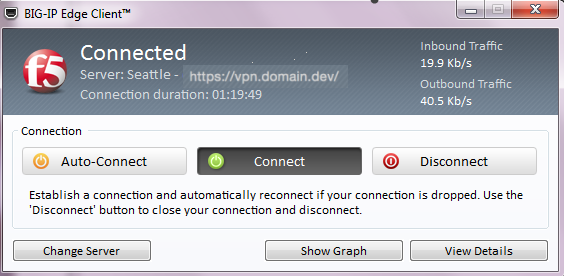Applies To:
Show Versions
BIG-IP APM
- 13.1.0
About Component Installer
The Component Installer service enables you to install and upgrade client-side Access Policy Manager® (APM®) components on Windows-based clients for all kinds of user accounts, regardless of the rights under which the user is working. This component is especially useful for installing and upgrading client-side components when the user has insufficient rights to install or upgrade the components directly.
After you install the Component Installer, it automatically installs and upgrades client-side APM components. It can also update itself. The Component Installer requires that installation or upgrade packages be signed using the F5® Networks certificate or another trusted certificate. By default, F5 Networks signs all components using the F5 Networks certificate.
Downloading and installing the Component Installer
Overview: Configuring and installing Edge Client for Windows
Users of BIG-IP® Edge Client®for Windows can connect securely and automatically to your network while roaming using the automatic reconnect, password caching, and location awareness features of Edge Client. You can also enforce Always Connected mode, and configure the list of trusted sites to which to allow access. You can customize the client package and you must download it and make it available to users as hosted content on the BIG-IP system or through another delivery mechanism. Users must install the package, or Component Installer, if available on the client, can install it for them.
Task summary
About Machine Cert Auth and user privilege
A Machine Cert Auth check requires administrative privilege. The Windows client package associated with a connectivity profile can be configured to include a Machine Certificate Checker Service component. The service can check the machine certificate on a client endpoint even when the user does not have admin privilege. The option to include this component in the package is disabled by default.
About Edge Client location awareness
The BIG-IP® Edge Client® provides a location-awareness feature. Using location awareness, the client connects automatically only when it is not on a specified network. The administrator specifies the networks that are considered in-network, by adding DNS suffixes to the connectivity profile. With a location-aware client enabled, a user with a corporate laptop can go from a corporate office, with a secured wireless or wired network connection, to an offsite location with a public wireless network connection, and maintain a seamless connection to allowed corporate resources.
About Edge Client automatic reconnection
BIG-IP®Edge Client® provides an automatic reconnection feature. This feature attempts to automatically reconnect the client system to corporate network resources whenever the client connection drops or ends prematurely.
About Always Connected mode
BIG-IP®Edge Client® provides Always Connected mode. This feature allows you to specify that the client is always connected to the VPN, and allows you to configure the behavior when the client is not connected. You can specify whether the client is connected automatically after Windows logon, and configure exclusion addresses.
Configuring a connectivity profile for Edge Client for Windows
Configuring Always Connected mode for the Windows Edge Client
Customizing a downloadable client package for Windows
Downloading the client package for Windows
About Network Access features for Windows-based clients
Access Policy Manager® (APM®) supports all Network Access features with BIG-IP® Edge Client® for Windows. For a complete list of Network Access features, refer to BIG-IP® Access Policy Manager®: Network Access on AskF5™ at http://support.f5.com/. For notes about endpoint security features, refer to BIG-IP® APM® Client Compatibility Matrix on AskF5™ at http://support.f5.com/.
About connection options on Edge Client for Windows

User interface on a Windows-based system
BIG-IP® Edge Client® for Windows user interface displays these connection options.
- Auto-Connect
- Starts a secure access connection as it is needed. This option uses the DNS suffix information defined in the connectivity profile to determine when the computer is on a defined local network. When the computer is not on a defined local network, the secure access connection starts. When the computer is on a local network, the client disconnects, but remains active in the system tray. This option does not display if DNS suffixes were not defined.
- Connect
- Starts and maintains a secure access connection at all times, regardless of the network location.
- Disconnect
- Stops an active secure access connection, and prevents the client from connecting again until a user clicks Connect or Auto-Connect.
About browser-based connections from Linux, Mac, and Windows clients
For Linux, Mac OS X, and Windows-based systems, the Network Access client component is available for automatic download from the BIG-IP® system.
The first time a remote user starts Network Access, APM® downloads a client component. This client component is designed to be self-installing and self-configuring. If the browser does not meet certain requirements, APM prompts the user to download the client component and install it manually.
Generating a troubleshooting report from Edge Client for Windows
Overview: Installing and using the client troubleshooting utility
Access Policy Manager® provides a client troubleshooting utility for Windows-based systems. Users can access the utility to check the availability and version information for Windows client components, and run Network Access diagnostic tests. The utility is integrated into BIG-IP® Edge Client® for Windows. To run Network Access diagnostics and troubleshooting reports on clients that have only the browser-based Network Access client component, you can download and install the client troubleshooting utility.
Task summary
Downloading the client troubleshooting utility
- On the Main screen, click the F5® logo to display the Welcome page.
- Scroll to the Downloads area.
- In the links for BIG-IP® Edge Client® Components, click Client Troubleshooting Utility for Windows.





